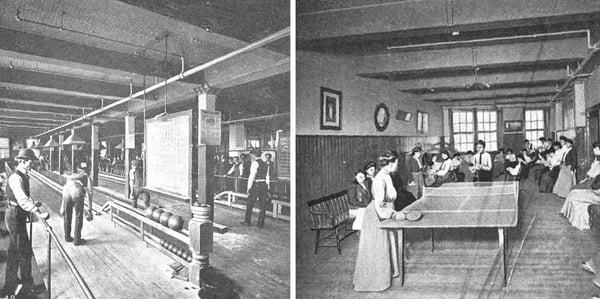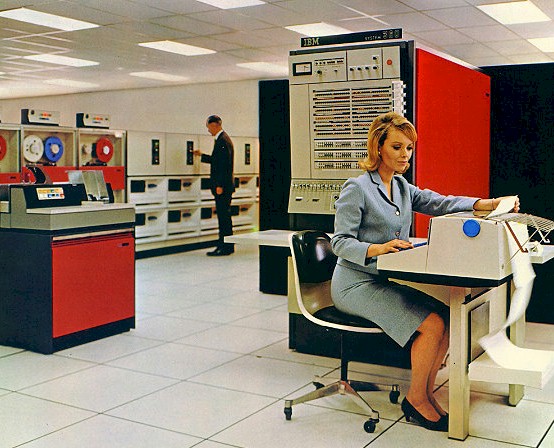
4 Moments That Changed HR Forever

Think you know your history? Over the last 150 years, the emergence of new technologies, business philosophies, and political movements have all played a part in shaping the HR profession as we know it today.
In Namely’s newest ebook, The History of HR, we dive into the full scope of that evolution. Below, we’ve included a sampling of the key moments in history that ultimately changed HR forever. Consider this your course syllabus.

1. The First HR Conference (1904)
Nearly a century before SHRM’s annual conference sold out exposition halls across the country, there was the Conference on Welfare Work. In 1904, the National Civic Federation invited business owners and personnel departments from across the country to the opulent Waldorf Astoria in New York City. The purpose? To exchange strategies on how to boost employee morale and wellbeing.
By this point, personnel management (called human resources today) was barely three years old. But in that short time, its thought leaders had created a variety of enticing perks to both attract and retain workers. Attendees, who hailed from all industries, shared “engagement hacks” like hosting Sunday picnics, screening silent movies at noon, and even providing employees with an on-site bar. And yes, there was ping pong as well.

Pictured: One company at the 1904 conference shared that it had built a bowling alley and game room for employees.
2. Passage of the Fair Labor Standards Act (1938)
Most of the employee protections we take for granted today didn’t exist before the mid-1930s. Child labor was legal, the minimum wage didn’t exist, and there were few workplace safety rules to speak of. If you were lucky enough to be employed during the Great Depression, your workweek was likely 50 or more hours long.
After a series of department store strikes across the country, President Franklin D. Roosevelt signed the most important labor law in U.S. history: the Fair Labor Standards Act (FLSA). The FLSA set limits on working age, capped the workweek to 44 hours, and created a minimum wage of 25 cents an hour. It also created a new form of compensation: overtime pay.
Almost overnight, HR teams had to shift focus. It wasn’t enough for companies to say they were compensating employees fairly—they needed to prove it. In 1940, even in wartime, the DOL conducted over 6,400 inspections and awarded workers over $5 million in back pay. Ever since the FLSA was passed, compliance has been an HR priority.
3. The HR Information System Arrives (1980s)
The first HR information system (HRIS) dates back to the 1970s, but it was prohibitively expensive, unintuitive, and physically cumbersome. Because all data had to be stored on location, offices sometimes had to dedicate entire rooms for the necessary hardware. For most companies, “going digital” was cost prohibitive and not so attractive of an alternative to using paper files.
By the early 1980s, personal computers had started to enter the workplace in growing numbers. This created the perfect conditions for the HRIS as we know it today. For the first time, employee and payroll data could be electronically stored in one place and easily referenced at a moment’s notice. From their office computer or a designated kiosk, employees could even access their own records without asking for help. These developments freed up hours of HR’s time, empowering them to focus on more strategic and forward-looking tasks.
 In the 1970s, personnel data was sometimes stored on physical, on-premises mainframes.
In the 1970s, personnel data was sometimes stored on physical, on-premises mainframes. 4. “People” Departments Emerge (2000s)
By the turn of the century, HR teams were dealing with an image crisis. With developments in computing and the eventual arrival of the internet, businesses had new opportunities to improve their bottom lines by automating tasks or transitioning roles overseas. That meant layoffs, and lots of them. In 1987 alone, an estimated 3.5 million U.S. workers lost their jobs. HR, tasked with giving employees the bad news themselves, were characterized as workplace “angels of death.”
The time was ripe for a rebrand. While the origin of the first “people” department remains unknown, what’s clear is that Silicon Valley led the charge. In the 2010s, Google and Facebook made headlines for their workplace cultures, unique perks, and novel take on the century-old HR profession. Suddenly, people operations had entered the corporate lexicon.
Need proof? Look no further than LinkedIn for a sampling of some of the HR job titles popular today. One industry report found that HR teams sometimes even used titles like Chief Happiness Officer, Head of Optimistic People, and People Guru. While it takes more than a rebrand to signal intent, the new verbiage represents a step in a new direction for the profession.

There’s no shortage of articles and opinions about the future of HR. But to get where you’re going, you need to know where you came from—and in HR’s case, that story is a surprisingly rich one, full of plot twists, memorable characters, and valuable lessons. Before making your own history, get the full story by reading our ebook, The History of HR.

See how Namely's flexible solution will help you streamline your HR processes by having your people, payroll, and benefits info all in on place.
Get a demoYou May Also Like
Get the latest news from Namely about HR, Payroll, and Benefits.
Thanks for subscribing!


Get the latest news from Namely about HR, Payroll, and Benefits.
Thanks for subscribing!



